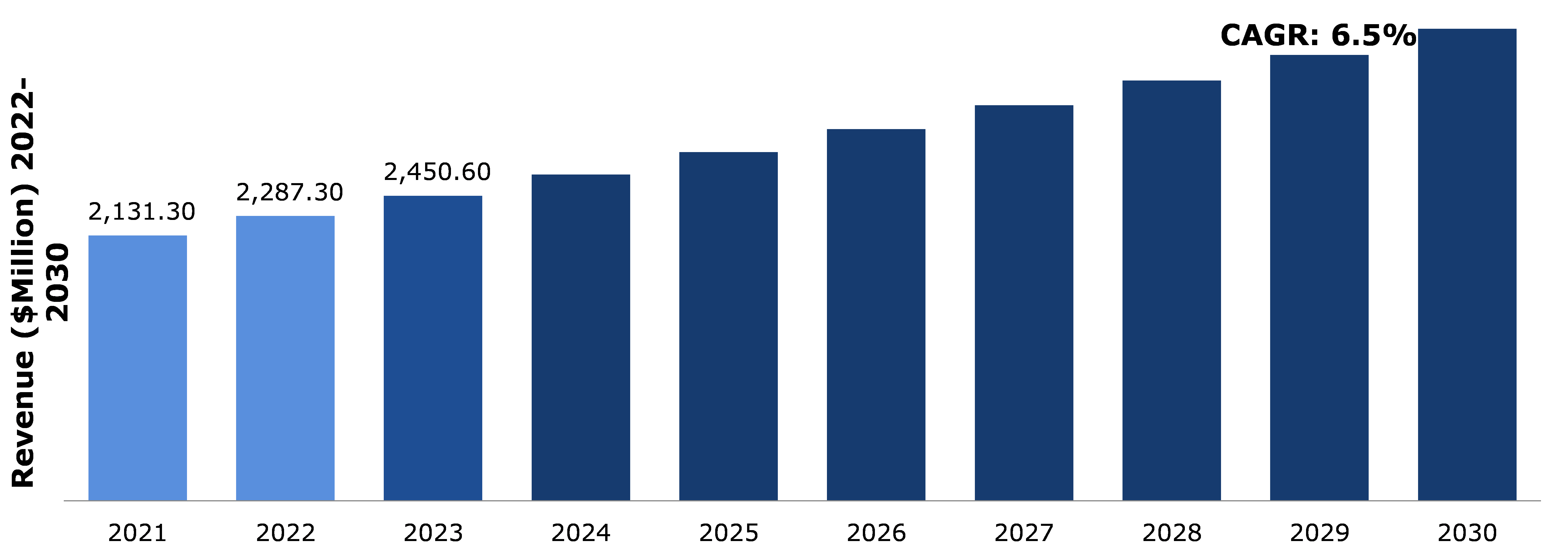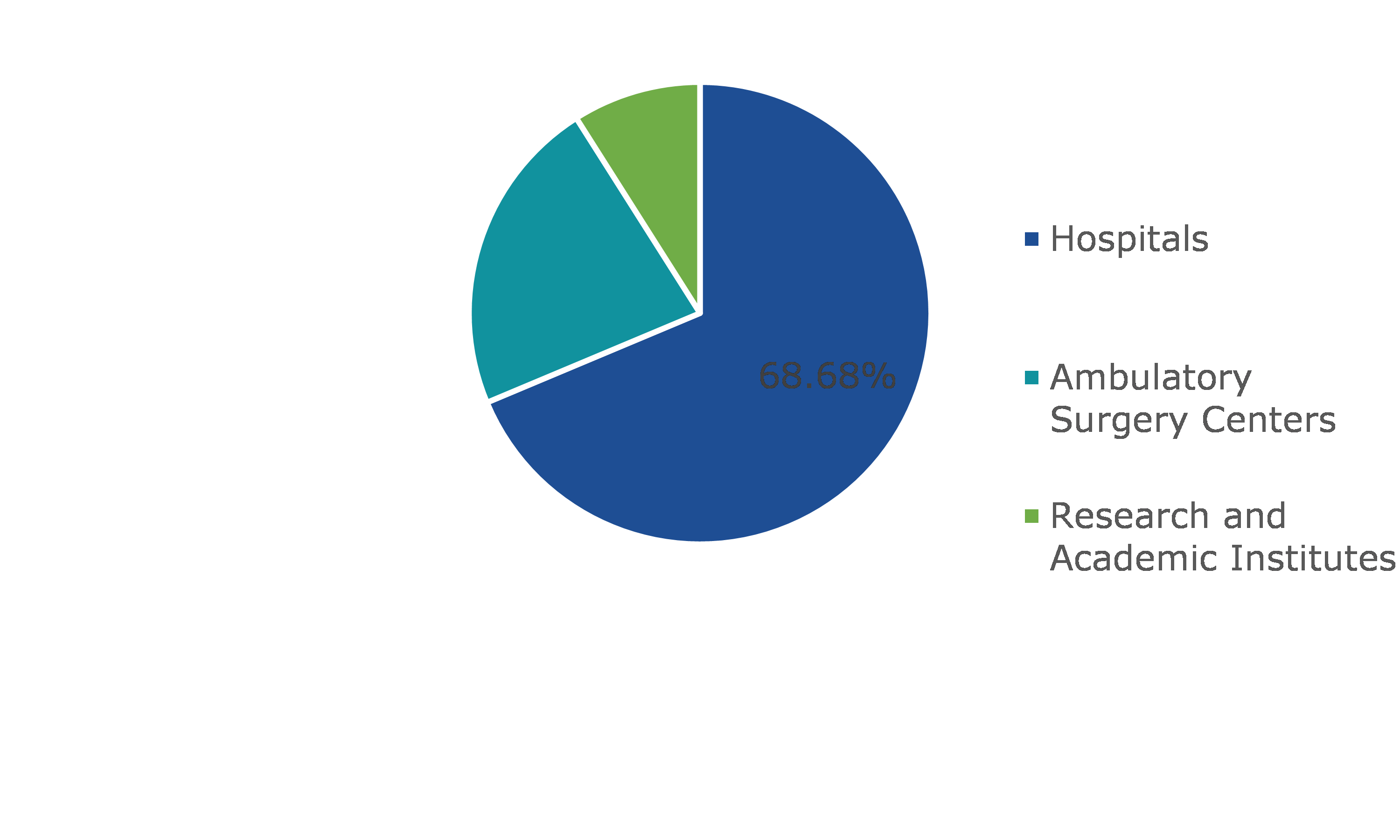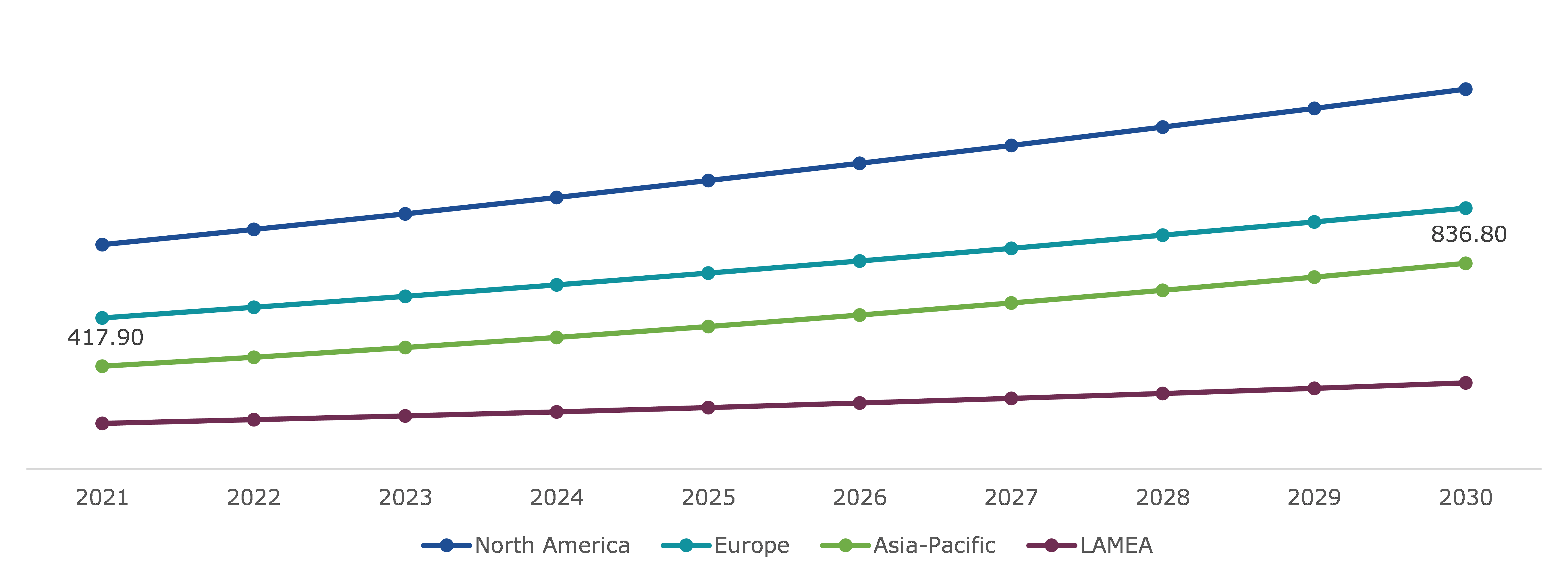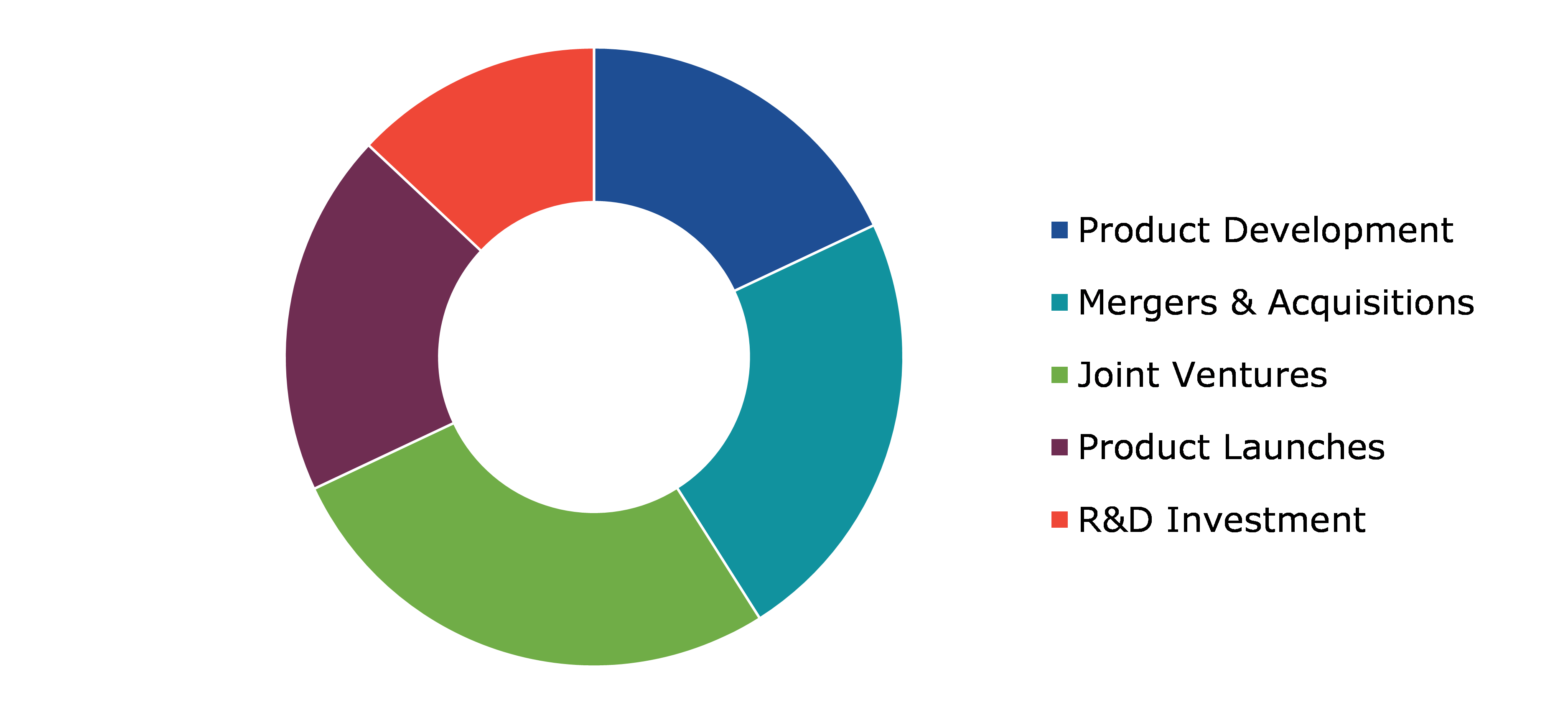Interventional Oncology Market Report
RA01567
Interventional Oncology Market by Product Type (Embolization Devices, Ablation Devices, and Support Devices), Caner Type (Liver Cancer, Lung Cancer, Bone Metastasis, Kidney Cancer, Breast Cancer, Prostate Cancer, and Other Cancers), End-user (Hospitals, Ambulatory Surgery Centers, and Research & Academic Institutes), and Regional Analysis (North America, Europe, Asia-Pacific, and LAMEA): Global Opportunity Analysis and Industry Forecast, 2022-2030
Global Interventional Oncology Market Analysis
According to the global interventional oncology market forecast, the market size is expected to reach up to $3,791.50 million by 2030, surging from $2,131.30 million in 2021, at a noteworthy CAGR of 6.5%.
Market Synopsis
Increasing rate of cancer cases worldwide to upsurge the global interventional oncology market growth. Cancer is one of the fastest growing medical conditions across the world. For instance, according to latest data collected by World Health Organization (WHO), in 2022, nearly 10 million cancer patients died in 2020, out of which breast cancer patients were maximum. Also, same report mentions that every year, approximately 2.26 million children, worldwide, suffer from cancer. Thus, the rising demand for a proper line of care program or a technique to manage cancer cases, worldwide, is expected to have an accelerating interventional oncology market share growth in the forecast time period.
However, lower product penetration of interventional oncology in the middle or low-income countries, may restrict the market growth. Apart from this, in many rural parts of developing countries, most people have low disposable income due to which they are unable to afford high healthcare expenses. Such factors are also responsible for hindering the interventional oncology market size growth rate in the coming years.
According to the regional analysis of the interventional oncology market, the Asia- Pacific market is expected to surge at a CAGR of 7.9%, by registering a revenue of $836.80 million, throughout the analysis period.
Interventional Oncology Overview
Interventional oncology (IO) is the emerging subspecialty that mainly utilizes image-guided procedures (diagnostics/surgeries) in order to improve cancer care. Along with surgical, medical, and radiation, now IO can be considered the 4th pillar of modern oncology care. IO is primarily emphasized on 3 prominent areas of cancer intervention namely therapy, diagnosis, and symptom palliation. Advances in cross-sectional imaging modalities like ultrasound, magnetic resonance (MR), computed tomography (CT), and positron emission tomography (PET) have enabled progress in IO (PET).
COVID-19 Impact on Interventional Oncology Market
The corona virus pandemic has had significantly disrupted the growth of the industries worldwide, creating a mass disturbance for sellers as well as buyers. Moreover, the pandemic of COVID-19 has deeply impacted the activity of IO in cancer centers and hospitals. In majority of the nations, clinic centers and hospitals have turned their operating theater to intensive care units (ICU) and mobilized oncologist to fight against coronavirus. Such elements have negatively affected the global interventional oncology market.
However, in November 2021, Quantum Surgical, France based innovative healthcare company, announced to exhibit an advanced robotic-assisted technology, Epione, at the Radiological Society of North America’s (RSNA) 2021. Epione is a new category of interventional oncology robotics that allows surgeons to plan, target, deliver, and confirm tumor ablation. Such inventions are further projected to create enormous opportunities, in the global interventional oncology market, post coronavirus outbreak.
Increasing Incidence of Cancer to Upsurge the Market Growth
Cancer is the 2nd leading cause of death worldwide and was responsible for almost 9.6 million deaths in 2018. Around 70% of deaths were reported from cancer in low- and middle-income economies. As per data published by the International Agency for Research on Cancer, intergovernmental agency forming part of the World Health Organization of the United Nations, in 2018, there were 17.0 million new cancer cases worldwide. By 2040, the global burden is predicted to increase to 27.5 million new cancer cases and 16.3 million cancer deaths mainly owing to the aging population across the globe. Inaccessible treatment options and late-stage diagnosis are the main elements responsible for growing mortality from cancerous diseases globally. All these facts and figures showcase that the demand for effective cancer care options is expected to rise, which may ultimately surge the global interventional oncology market.
To know more about global interventional oncology market drivers, get in touch with our analysts here.
Lower Product Penetration in the Low-income Regions to Restrain the Market Growth
However, lack of information regarding the interventional oncology across the middle or low-income countries may restrain the market growth of global interventional oncology market, throughout the projected period. Further, high cost of interventional oncology devices may also negatively impact the interventional oncology market, in the coming years. Apart from this, lack of reimbursements policies in many countries is also likely to impede market share growth in the
Significant Expansion of Healthcare Establishments across the Asia-Pacific Region to Create Investment Opportunities
Asian countries such as India, Japan, China, and Singapore have experienced notable expansion of hospitals & healthcare equipment manufacturers in the recent several years. Furthermore, the extensively increasing awareness among the Asian consumers regarding enhancing the cancer care has also increased. In addition to this, burden of various chronic cancerous conditions along with geriatric population is increasing in the APAC region. Thereby, the adoption and constant growth of interventional oncology in this region have increased, which can create the market opportunities for global interventional oncology industry, in the forecast period. Also, IO has also advanced with integration of latest technology. Artificial intelligence and robotic technology have the potential to improve needle placement precision and reduce overall operation time. New 3D imaging and contrast agents, as well as therapeutic ultrasound development, could lead to new breakthroughs in this imaging modality for IO. Biopsies of aggressive tumor regions can be guided using specific ultrasonic agents. Another growing field is high-intensity targeted ultrasound ablation.
To know more about global interventional oncology market opportunities, get in touch with our analysts here.
Global Interventional Oncology Market, by Product Type
Based on product type, the market has been divided into embolization devices, ablation devices, and support devices sub-segments of which the embolization devices sub-segment is anticipated to garner the dominant market share, throughout the analysis period.
Global Interventional Oncology Market Share, By Product Type, 2021
Source: Research Dive Analysis
The embolization devices sub-segment is expected to have the dominating share in the global market and register a revenue of $2,522.50 million by 2030.
Embolization devices mainly comprised of radio embolic agents and non-radioactive embolic agents. These devices play crucial role in the treatment of hepatocellular carcinoma, and various other forms of cancer in which the tumor size is large. Moreover, embolization devices are also utilized in palliative procedures in order to enhance the outcome of liver resection. All these factors are expected to augment the growth of embolization sub-segment, in the analysis period.
Global Interventional Oncology Market, by Cancer Type
Based on cancer type, the market has been divided into liver cancer, lung cancer, bone metastasis, kidney cancer, breast cancer, prostate cancer, and other cancers sub-segments of which the liver cancer sub-segment is anticipated to have maximum share, throughout the analysis period.
Global Interventional Oncology Market Share, by Cancer Type, 2021 & 2030
Source: Research Dive Analysis
The liver cancer sub-segment is expected to have the dominating share in the global market and register a revenue of $1,153.80 million by 2030.
Interventional oncology has important part in treating liver tumor with keeping healthy liver for effective functioning. Thus, primary liver tumors caused by metastatic cancer can be successfully treated by advanced interventional oncology surgeries. In addition to this, growing cases of liver cancer worldwide along with rising research/development activities utilizing interventional oncology in order to enhance liver cancer therapies are some of the elements bolstering the liver cancer sub-segment’s growth.
Global Interventional Oncology Market, by End-user
Based on end-user, the market has been categorized into hospitals, ambulatory surgery centers, and research & academic institutes. Out of these, the hospitals sub-segment is anticipated to garner the maximum revenue in the global market, throughout the analysis period.
Global Interventional Oncology Market Share, By End-user, 2021
Source: Research Dive Analysis
The hospitals sub-segment of the global interventional oncology market holds prominent share and is estimated to surpass $2,589.70 million by 2030, with a rise from $1,463.70 million in 2021.Massive increase in the prevalence of cancer worldwide, increase in awareness about advanced oncological therapies in developing region, and noticeable R&D funding are some of the driving elements fueling the sub-segment’s growth. Along with this, enhancement of healthcare infrastructure and surged adoption of innovative interventional oncology devices such as embolization and ablation devices in the hospitals may create enormous opportunities for the hospitals sub-segment, in the coming years.
Global Interventional Oncology Market, Regional Insights:
The interventional oncology market was investigated across North America, Europe, Asia-Pacific, and LAMEA.
Global Interventional Oncology Market Size & Forecast, By Region, 2021-2030 (USD Million)
Source: Research Dive Analysis
The Market for Interventional Oncology in Asia-Pacific to be the Most Lucrative
Asia-Pacific interventional oncology market accounted $417.90 million in 2021 and is projected to generate a revenue of $836.80 million by 2030.
The massive support from the government authorities to fortify effective innovative cancer diagnostics and treatment in Asian countries, is one of the major reasons driving interventional oncology market, in the APAC region. Also, Asia-Pacific region is backed by huge population base in countries, namely China and India, where enormous improvements in healthcare infrastructure are taking place. Moreover, the increasing awareness programs initiated by government as well as non-governmental bodies are contributing to the growth of the interventional oncology market in Asia-pacific region.
The Market for Interventional Oncology in North America to be the Most Dominant
Interventional oncology market in North America region is highly competitive and leading companies in the market are adopting multiple strategies to garner maximum North America interventional oncology market share. North America interventional oncology market accounted $912.60 million in 2021 and is expected to register a revenue of $1,544.30 million by 2030.
Furthermore, increase in the geriatric population along with growing cancer prevalence & incidence is creating positive impact on the North America interventional oncology market. In addition to this, key elements like rising cancer related healthcare expenditure and growing need for state-of-the-art cancer care options are surging the adoption of interventional oncology in the US and Canada.
Competitive Scenario in the Global Interventional Oncology Market
Treatment type launches and mergers & acquisitions are common strategies followed by major market players.
Source: Research Dive Analysis
Some of the leading interventional oncology market players are Medtronic, Boston Scientific, BD, Terumo, Merit Medical, AngioDynamics, J&J, Teleflex, Cook Medical, and HealthTronics.
| Aspect | Particulars |
| Historical Market Estimations | 2020-2021 |
| Base Year for Market Estimation | 2021 |
| Forecast timeline for Market Projection | 2022-2030 |
| Geographical Scope | North America, Europe, Asia-Pacific, LAMEA |
| Segmentation by Product Type |
|
| Segmentation by Cancer Type |
|
| Segmentation by End-user |
|
| Key Countries Covered | U.S., Canada, Mexico, Germany, France, UK, Italy, Spain, Russia, Rest of Europe, China, Japan, India, Australia, South Korea, Rest of Asia-Pacific, Brazil, Saudi Arabia, United Arab Emirates, Rest of LAMEA |
| Key Companies Profiled |
|
Q1. How big is the interventional oncology market?
A. The global interventional oncology market size was over $2,131.30 million in 2021 and is projected to reach $3,791.50 million by 2030.
Q2. Which are the major companies in the interventional oncology market?
A. Cook Medical and HealthTronics are some of the key players in the global interventional oncology Market.
Q3. Which region possesses greater investment opportunities in the coming future?
A. The Asia-Pacific region possesses great investment opportunities for the investors to witness the most promising growth in the future.
Q4. What is the growth rate of the Asia-Pacific market?
A. Asia-Pacific interventional oncology market is anticipated to grow at 7.9% CAGR during the forecast period.
Q5. What are the strategies opted by the leading players in this market?
A. Capacity expansion, treatment type development, along with joint ventures are the key strategies opted by the operating companies in this market.
Q6. Which companies are investing more on R&D practices?
A. Merit Medical and AngioDynamics are investing more on R&D activities for developing new treatment types and technologies.
Q7. What does an interventional oncologist do?
A. Interventional oncologist addresses the diagnosis and treatment of cancer by using minimally invasive surgeries performed with image guidance.
Q8. Is interventional radiology used for cancer?
A. Yes. Interventional radiology can be used for the cancer treatment.
Q9. Is oncology the same as chemotherapy?
A. Yes. Oncology is same as chemotherapy.
Q10. What is the difference between interventional radiology and radiation oncology?
A. Radiation oncologists treat cancers through the medical use of ionizing radiation while in interventional radiology, trained surgeons use minimally invasive procedures to diagnose and treat cancer.
Q11. How do you become an interventional oncologist?
A. Interventional oncologist are fellowship trained and board-certified physicians who specialize in targeted and minimally invasive treatment. Interventional oncologist should be graduated from the medical college, pass a licensing exam, and complete at-least 5 years of graduate medical education.
1.Research Methodology
1.1.Desk Research
1.2.Real time insights and validation
1.3.Forecast model
1.4.Assumptions and forecast parameters
1.5.Market size estimation
1.5.1.Top-down approach
1.5.2.Bottom-up approach
2.Report Scope
2.1.Market definition
2.2.Key objectives of the study
2.3.Report overview
2.4.Market segmentation
2.5.Overview of the impact of COVID-19 on Global interventional oncology market
3.Executive Summar
4.Market Overview
4.1.Introduction
4.2.Growth impact forces
4.2.1.Drivers
4.2.2.Restraints
4.2.3.Opportunities
4.3.Market value chain analysis
4.3.1.List of raw material suppliers
4.3.2.List of manufacturers
4.3.3.List of distributors
4.4.Innovation & sustainability matrices
4.4.1.Cancer Type matrix
4.4.2.Regulatory matrix
4.5.Porter’s five forces analysis
4.5.1.Bargaining power of suppliers
4.5.2.Bargaining power of consumers
4.5.3.Threat of substitutes
4.5.4.Threat of new entrants
4.5.5.Competitive rivalry intensity
4.6.PESTLE analysis
4.6.1.Political
4.6.2.Economical
4.6.3.Social
4.6.4.Technological
4.6.5.Environmental
4.7.Impact of COVID-19 on interventional oncology market
4.7.1.Pre-covid market scenario
4.7.2.Post-covid market scenario
5.Interventional Oncology Market, by Product type
5.1.Overview
5.1.1.Market size and forecast, by Product type
5.2.Embolization Devices
5.2.1.Key market trends, growth factors, and opportunities
5.2.2.Market size and forecast, by region, 2022-2030
5.2.3.Market share analysis, by country 2022 & 2030
5.3.Ablation Devices
5.3.1.Key market trends, growth factors, and opportunities
5.3.2.Market size and forecast, by region, 2022-2030
5.3.3.Market share analysis, by country 2022 & 2030
5.4.Support Devices
5.4.1.Key market trends, growth factors, and opportunities
5.4.2.Market size and forecast, by region, 2022-2030
5.4.3.Market share analysis, by country 2022 & 2030
5.5.Research Dive Exclusive Insights
5.5.1.Market attractiveness
5.5.2.Competition heatmap
6.Interventional Oncology Market, by Cancer Type
6.1.Overview
6.1.1.Market size and forecast, by Cancer Type
6.2.Liver Cancer
6.2.1.Key market trends, growth factors, and opportunities
6.2.2.Market size and forecast, by region, 2022-2030
6.2.3.Market share analysis, by country 2022 & 2030
6.3.Lung Cancer
6.3.1.Key market trends, growth factors, and opportunities
6.3.2.Market size and forecast, by region, 2022-2030
6.3.3.Market share analysis, by country 2022 & 2030
6.4.Bone Metastasis
6.4.1.Key market trends, growth factors, and opportunities
6.4.2.Market size and forecast, by region, 2022-2030
6.4.3.Market share analysis, by country 2022 & 2030
6.5.Kidney Cancer
6.5.1.Key market trends, growth factors, and opportunities
6.5.2.Market size and forecast, by region, 2022-2030
6.5.3.Market share analysis, by country 2022 & 2030
6.6.Breast Cancer
6.6.1.Key market trends, growth factors, and opportunities
6.6.2.Market size and forecast, by region, 2022-2030
6.6.3.Market share analysis, by country 2022 & 2030
6.7.Prostate Cancer
6.7.1.Key market trends, growth factors, and opportunities
6.7.2.Market size and forecast, by region, 2022-2030
6.7.3.Market share analysis, by country 2022 & 2030
6.8.Others
6.8.1.Key market trends, growth factors, and opportunities
6.8.2.Market size and forecast, by region, 2022-2030
6.8.3.Market share analysis, by country 2022 & 2030
6.9.Research Dive Exclusive Insights
6.9.1.Market attractiveness
6.9.2.Competition heatmap
7.Interventional Oncology Market, by End-User
7.1.Overview
7.1.1.Market size and forecast, by End-User
7.2.Hospitals
7.2.1.Key market trends, growth factors, and opportunities
7.2.2.Market size and forecast, by region, 2022-2030
7.2.3.Market share analysis, by country 2022 & 2030
7.3.Ambulatory Surgery Centers
7.3.1.Key market trends, growth factors, and opportunities
7.3.2.Market size and forecast, by region, 2022-2030
7.3.3.Market share analysis, by country 2022 & 2030
7.4.Research & Academic Institutes
7.4.1.Key market trends, growth factors, and opportunities
7.4.2.Market size and forecast, by region, 2022-2030
7.4.3.Market share analysis, by country 2022 & 2030
7.5.Research Dive Exclusive Insights
7.5.1.Market attractiveness
7.5.2.Competition heatmap
8.Interventional Oncology Market, by Region
8.1.North America
8.1.1.U.S.
8.1.1.1.Market size analysis, by Product type
8.1.1.2.Market size analysis, by Cancer Type
8.1.1.3.Market size analysis, by End-User
8.1.2.Canada
8.1.2.1.Market size analysis, by Product type
8.1.2.2.Market size analysis, by Cancer Type
8.1.2.3.Market size analysis, by End-User
8.1.3.Mexico
8.1.3.1.Market size analysis, by Product type
8.1.3.2.Market size analysis, by Cancer Type
8.1.3.3.Market size analysis, by End-User
8.1.4.Research Dive Exclusive Insights
8.1.4.1.Market attractiveness
8.1.4.2.Competition heatmap
8.2.Europe
8.2.1.Germany
8.2.1.1.Market size analysis, by Product type
8.2.1.2.Market size analysis, by Cancer Type
8.2.1.3.Market size analysis, by End-User
8.2.2.UK
8.2.2.1.Market size analysis, by Product type
8.2.2.2.Market size analysis, by Cancer Type
8.2.2.3.Market size analysis, by End-User
8.2.3.France
8.2.3.1.Market size analysis, by Product type
8.2.3.2.Market size analysis, by Cancer Type
8.2.3.3.Market size analysis, by End-User
8.2.4.Spain
8.2.4.1.Market size analysis, by Product type
8.2.4.2.Market size analysis, by Cancer Type
8.2.4.3.Market size analysis, by End-User
8.2.5.Italy
8.2.5.1.Market size analysis, by Product type
8.2.5.2.Market size analysis, by Cancer Type
8.2.5.3.Market size analysis, by End-User
8.2.6.Rest of Europe
8.2.6.1.Market size analysis, by Product type
8.2.6.2.Market size analysis, by Cancer Type
8.2.6.3.Market size analysis, by End-User
8.2.7.Research Dive Exclusive Insights
8.2.7.1.Market attractiveness
8.2.7.2.Competition heatmap
8.3.Asia Pacific
8.3.1.China
8.3.1.1.Market size analysis, by Product type
8.3.1.2.Market size analysis, by Cancer Type
8.3.1.3.Market size analysis, by End-User
8.3.2.Japan
8.3.2.1.Market size analysis, by Product type
8.3.2.2.Market size analysis, by Cancer Type
8.3.2.3.Market size analysis, by End-User
8.3.3.India
8.3.3.1.Market size analysis, by Product type
8.3.3.2.Market size analysis, by Cancer Type
8.3.3.3.Market size analysis, by End-User
8.3.4.Australia
8.3.4.1.Market size analysis, by Product type
8.3.4.2.Market size analysis, by Cancer Type
8.3.4.3.Market size analysis, by End-User
8.3.5.South Korea
8.3.5.1.Market size analysis, by Product type
8.3.5.2.Market size analysis, by Cancer Type
8.3.5.3.Market size analysis, by End-User
8.3.6.Rest of Asia Pacific
8.3.6.1.Market size analysis, by Product type
8.3.6.2.Market size analysis, by Cancer Type
8.3.6.3.Market size analysis, by End-User
8.3.7.Research Dive Exclusive Insights
8.3.7.1.Market attractiveness
8.3.7.2.Competition heatmap
8.4.LAMEA
8.4.1.Brazil
8.4.1.1.Market size analysis, by Product type
8.4.1.2.Market size analysis, by Cancer Type
8.4.1.3.Market size analysis, by End-User
8.4.2.Saudi Arabia
8.4.2.1.Market size analysis, by Product type
8.4.2.2.Market size analysis, by Cancer Type
8.4.2.3.Market size analysis, by End-User
8.4.3.UAE
8.4.3.1.Market size analysis, by Product type
8.4.3.2.Market size analysis, by Cancer Type
8.4.3.3.Market size analysis, by End-User
8.4.4.South Africa
8.4.4.1.Market size analysis, by Product type
8.4.4.2.Market size analysis, by Cancer Type
8.4.4.3.Market size analysis, by End-User
8.4.5.Rest of LAMEA
8.4.5.1.Market size analysis, by Product type
8.4.5.2.Market size analysis, by Cancer Type
8.4.5.3.Market size analysis, by End-User
8.4.6.Research Dive Exclusive Insights
8.4.6.1.Market attractiveness
8.4.6.2.Competition heatmap
9.Competitive Landscape
9.1.Top winning strategies, 2021
9.1.1.By strategy
9.1.2.By year
9.2.Strategic overview
9.3.Market share analysis, 2021
10.Company Profiles
10.1.Medtronic
10.1.1.Overview
10.1.2.Business segments
10.1.3.Product portfolio
10.1.4.Financial performance
10.1.5.Recent developments
10.1.6.SWOT analysis
10.2.Boston Scientific
10.2.1.Overview
10.2.2.Business segments
10.2.3.Product portfolio
10.2.4.Financial performance
10.2.5.Recent developments
10.2.6.SWOT analysis
10.3.BD
10.3.1.Overview
10.3.2.Business segments
10.3.3.Product portfolio
10.3.4.Financial performance
10.3.5.Recent developments
10.3.6.SWOT analysis
10.4.Terumo
10.4.1.Overview
10.4.2.Business segments
10.4.3.Product portfolio
10.4.4.Financial performance
10.4.5.Recent developments
10.4.6.SWOT analysis
10.5.Merit Medical
10.5.1.Overview
10.5.2.Business segments
10.5.3.Product portfolio
10.5.4.Financial performance
10.5.5.Recent developments
10.5.6.SWOT analysis
10.6.AngioDynamics
10.6.1.Overview
10.6.2.Business segments
10.6.3.Product portfolio
10.6.4.Financial performance
10.6.5.Recent developments
10.6.6.SWOT analysis
10.7.J&J
10.7.1.Overview
10.7.2.Business segments
10.7.3.Product portfolio
10.7.4.Financial performance
10.7.5.Recent developments
10.7.6.SWOT analysis
10.8.Teleflex
10.8.1.Overview
10.8.2.Business segments
10.8.3.Product portfolio
10.8.4.Financial performance
10.8.5.Recent developments
10.8.6.SWOT analysis
10.9.Cook Medical
10.9.1.Overview
10.9.2.Business segments
10.9.3.Product portfolio
10.9.4.Financial performance
10.9.5.Recent developments
10.9.6.SWOT analysis
10.10.HealthTronics
10.10.1.Overview
10.10.2.Business segments
10.10.3.Product portfolio
10.10.4.Financial performance
10.10.5.Recent developments
10.10.6.SWOT analysis
11.Appendix
11.1.Parent & peer market analysis
11.2.Premium insights from industry experts
11.3.Related reports
Interventional oncology (IO) is an emerging subspecialty that utilizes image-guided surgeries or procedures to improve cancer care across the world. Advancements in IO include cross-sectional imaging modalities like magnetic resonance, computed tomography, and positron emission tomography. In addition, the intervention oncology has developed over the years with its shift towards more patient-centered and personalized treatment approached. Furthermore, one of the latest innovations in intervention oncology is offering therapeutic agents directly into the cancer tumors by direct intratumoral injection or catheter. Also, guided imaging has also been utilized for offering bacterial and viral therapies to destroy cancer cells.
COVID-19 Impact on the Market
The onset of the Covid-19 pandemic has negatively affected the global interventional oncology market. Due to strict lockdowns and mobility restrictions imposed by governments, several hospitals and clinic centers turned their operating units to intensive care units (ICU), thus impacting the market growth during the pandemic. However, a few healthcare companies exhibited innovative technologies to aid in planning, targeting, and delivering tumor ablation. This factor is anticipated to offer enormous growth opportunities for the interventional oncology market post pandemic.
Key Developments of the Market
The major companies operating in the industry are adopting numerous growth strategies & business tactics such as partnerships, collaborations, mergers & acquisitions, and launches to maintain a robust position in the overall market, which is subsequently helping the global interventional oncology market to grow exponentially. For instance:
In July 2021, Rajiv Gandhi Cancer Institute and Research Center announced its decision to install Siemens Healthineers’ BioMatrix 3T MR System- MAGNETOM Vida. This is the first 3T MR scanner that is built to overcome imaging challenges by adjusting automatically to the patient’s bio variability for enabling personalized examinations. Some of the attractive benefits of MAGNETOM Vida are fewer rescans, high-quality personalized exams for clinical research, and predictable scheduling. Its field strength is 3 Tesla and has zero helium boil-off technology along with both active and passive shimming.
In November 2021, MEDX Xelerator, an Israeli-based medical device incubator, announced its collaboration agreement with West Pharmaceutical Services, an established company in injectable drug administration. The latter has agreed to offer funding for the initial phases of concept venture creations at the incubator. Moreover, the funding would be majorly used to assist growing number of personnel required to manage the incubator projects.
In December 2021, Argon Medical Devices Inc., a leading manufacturer of interventional medical devices, announced its acquisition of Matrex Mold & Tool Inc., a custom mold manufacturer for plastic injection molding. The decision was made with an aim to supply products despite widespread supply chain disruptions and transportation delays.
Forecast Analysis of the Interventional Oncology Market
According to the report published by Research Dive, the global interventional oncology market is expected to generate a revenue of $3,791.50 million in the 2022-2030 timeframe, growing exponentially at a CAGR of 6.5%.
Increasing rate of cancer cases among people across the world and the growing aging population are the main factors predicted to drive the global interventional oncology market by 2030. In addition, noteworthy expansion of medical and healthcare establishments across countries like Japan, India, and China is expected to offer abundant growth opportunities for the market during the analysis timeframe. However, lack of information regarding intervention oncology in establishing countries is the prime factor anticipated to impede the market growth during the forecast years.
Regionally, the interventional oncology market in the North America region is estimated to observe tremendous growth and register a revenue of $912.60 million by 2030 owing to the increasing geriatric population along with the prevalence of cancer among people. In addition, growing cancer-centric healthcare expenditure and need for advanced cancer care options in the US and Canada is further expected to boost the growth of interventional oncology market in the North America region.
The major players of the interventional oncology market include Medtronic, BD, Boston Scientific, Terumo, AngioDynamics, Merit Medical, J&J, Cook Medical, Teleflex, and HealthTronics.
Personalize this research
- Triangulate with your own data
- Request your format and definition
- Get a deeper dive on a specific application, geography, customer or competitor
- + 1-888-961-4454 Toll - Free
- support@researchdive.com







